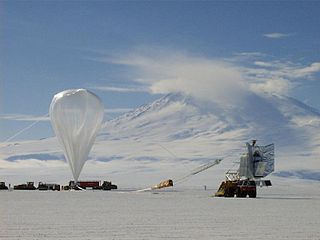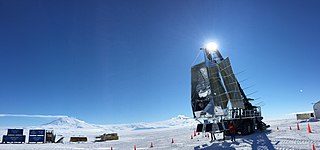Related Research Articles

The cosmic microwave background is microwave radiation that fills all space in the observable universe. It is a remnant that provides an important source of data on the primordial universe. With a standard optical telescope, the background space between stars and galaxies is almost completely dark. However, a sufficiently sensitive radio telescope detects a faint background glow that is almost uniform and is not associated with any star, galaxy, or other object. This glow is strongest in the microwave region of the radio spectrum. The accidental discovery of the CMB in 1965 by American radio astronomers Arno Penzias and Robert Wilson was the culmination of work initiated in the 1940s.

The Wilkinson Microwave Anisotropy Probe (WMAP), originally known as the Microwave Anisotropy Probe, was a NASA spacecraft operating from 2001 to 2010 which measured temperature differences across the sky in the cosmic microwave background (CMB) – the radiant heat remaining from the Big Bang. Headed by Professor Charles L. Bennett of Johns Hopkins University, the mission was developed in a joint partnership between the NASA Goddard Space Flight Center and Princeton University. The WMAP spacecraft was launched on 30 June 2001 from Florida. The WMAP mission succeeded the COBE space mission and was the second medium-class (MIDEX) spacecraft in the NASA Explorer program. In 2003, MAP was renamed WMAP in honor of cosmologist David Todd Wilkinson (1935–2002), who had been a member of the mission's science team. After nine years of operations, WMAP was switched off in 2010, following the launch of the more advanced Planck spacecraft by European Space Agency (ESA) in 2009.
The Sunyaev–Zeldovich effect is the spectral distortion of the cosmic microwave background (CMB) through inverse Compton scattering by high-energy electrons in galaxy clusters, in which the low-energy CMB photons receive an average energy boost during collision with the high-energy cluster electrons. Observed distortions of the cosmic microwave background spectrum are used to detect the disturbance of density in the universe. Using the Sunyaev–Zeldovich effect, dense clusters of galaxies have been observed.
Observational cosmology is the study of the structure, the evolution and the origin of the universe through observation, using instruments such as telescopes and cosmic ray detectors.

In astronomy and observational cosmology, the BOOMERanG experiment was an experiment which measured the cosmic microwave background radiation of a part of the sky during three sub-orbital (high-altitude) balloon flights. It was the first experiment to make large, high-fidelity images of the CMB temperature anisotropies, and is best known for the discovery in 2000 that the geometry of the universe is close to flat, with similar results from the competing MAXIMA experiment.

The Atacama Cosmology Telescope (ACT) was a cosmological millimeter-wave telescope located on Cerro Toco in the Atacama Desert in the north of Chile. ACT made high-sensitivity, arcminute resolution, microwave-wavelength surveys of the sky in order to study the cosmic microwave background radiation (CMB), the relic radiation left by the Big Bang process. Located 40 km from San Pedro de Atacama, at an altitude of 5,190 metres (17,030 ft), it was one of the highest ground-based telescopes in the world.

George Fitzgerald Smoot III is an American astrophysicist, cosmologist, Nobel laureate, and the second contestant to win the $1 million prize on Are You Smarter than a 5th Grader?. He won the Nobel Prize in Physics in 2006 for his work on the Cosmic Background Explorer with John C. Mather that led to the "discovery of the black body form and anisotropy of the cosmic microwave background radiation".
The Degree Angular Scale Interferometer (DASI) was a telescope installed at the U.S. National Science Foundation's Amundsen–Scott South Pole Station in Antarctica. It was a 13-element interferometer operating between 26 and 36 GHz in ten bands. The instrument is similar in design to the Cosmic Background Imager (CBI) and the Very Small Array (VSA). In 2001 The DASI team announced the most detailed measurements of the temperature, or power spectrum of the Cosmic microwave background (CMB). These results contained the first detection of the 2nd and 3rd acoustic peaks in the CMB, which were important evidence for inflation theory. This announcement was done in conjunction with the BOOMERanG and MAXIMA experiment. In 2002 the team reported the first detection of polarization anisotropies in the CMB.

Spider is a balloon-borne experiment designed to search for primordial gravitational waves imprinted on the cosmic microwave background (CMB). Measuring the strength of this signal puts limits on inflationary theory.
QMAP was a balloon experiment to measure the anisotropy of the cosmic microwave background (CMB). It flew twice in 1996, and was used with an interlocking scan of the skies to produce CMB maps at angular scales between 0.7° and 9°.

Archeops was a balloon-borne instrument dedicated to measuring the Cosmic microwave background (CMB) temperature anisotropies. The study of this radiation is essential to obtain precise information on the evolution of the Universe: density, Hubble constant, age of the Universe, etc. To achieve this goal, measurements were done with devices cooled down at 100mK temperature placed at the focus of a warm telescope. To avoid atmospheric disturbance the whole apparatus is placed on a gondola below a helium balloon that reaches 40 km altitude.

An airborne observatory is an airplane, airship, or balloon with an astronomical telescope. By carrying the telescope to a sufficiently high altitude, the telescope can avoid cloud cover, pollution, and carry out observations in the infrared spectrum, above water vapor in the atmosphere which absorbs infrared radiation. Some drawbacks to this approach are the instability of the lifting platform, the weight restrictions on the instrument, the need to safely recover the gear afterward, and the cost compared to a comparable ground-based observatory.
Andrew E. Lange was an astrophysicist and Goldberger Professor of Physics at the California Institute of Technology in Pasadena, California. Lange came to Caltech in 1993 and was most recently the chair of the Division of Physics, Mathematics and Astronomy. Caltech's president Jean-Lou Chameau called him "a truly great physicist and astronomer who had made seminal discoveries in observational cosmology".

BICEP and the Keck Array are a series of cosmic microwave background (CMB) experiments. They aim to measure the polarization of the CMB; in particular, measuring the B-mode of the CMB. The experiments have had five generations of instrumentation, consisting of BICEP1, BICEP2, the Keck Array, BICEP3, and the BICEP Array. The Keck Array started observations in 2012 and BICEP3 has been fully operational since May 2016, with the BICEP Array beginning installation in 2017/18.

A balloon-borne telescope is a type of airborne telescope, a sub-orbital astronomical telescope that is suspended below one or more stratospheric balloons, allowing it to be lifted above the lower, dense part of the Earth's atmosphere. This has the advantage of improving the resolution limit of the telescope at a much lower cost than for a space telescope. It also allows observation of frequency bands that are blocked by the atmosphere.

The Cosmology Large Angular Scale Surveyor (CLASS) is an array of microwave telescopes at a high-altitude site in the Atacama Desert of Chile as part of the Parque Astronómico de Atacama. The CLASS experiment aims to improve our understanding of cosmic dawn when the first stars turned on, test the theory of cosmic inflation, and distinguish between inflationary models of the very early universe by making precise measurements of the polarization of the Cosmic Microwave Background (CMB) over 65% of the sky at multiple frequencies in the microwave region of the electromagnetic spectrum.
John Richard Bond, also known as J. Richard Bond, is a Canadian astrophysicist and cosmologist.
Michele Limon is an Italian research scientist at the University of Pennsylvania. Limon studied physics at the Università degli Studi di Milano in Milan, Italy and completed his post-doctoral work at the University of California, Berkeley. He has been conducting research for more than 30 years and has experience in the design of ground, balloon and space-based instrumentation. His academic specialties include Astrophysics, Cosmology, Instrumentation Development, and Cryogenics.
Abigail Goodhue Vieregg is a professor of physics at the Enrico Fermi Institute and Kavli Institute of Cosmology, University of Chicago, specializing in neutrino astrophysics and cosmology. Her work focuses on cosmic high-energy neutrinos and mapping the cosmic microwave background.
References
- 1 2 3 4 5 http://www.astro.utoronto.ca/~netterfield/ Barth Netterfield personal home page at U of T
- 1 2 http://www.nserc-crsng.gc.ca/Prizes-Prix/Steacie-Steacie/Profiles-Profils_eng.asp?ID=1010 Steacie award profile page at NSERC (for citation a, see paragraph 7)
- 1 2 3 "Press Releases". Archived from the original on 2014-04-19. Retrieved 2012-06-08. 2007 CAP Herzberg Medal press release
- ↑ Glanz, James (27 April 2000). "Clearest Picture of Infant Universe Sees It All and Questions It, Too". The New York Times . Retrieved 2012-06-08.
- ↑ Netterfield, C. B.; Ade, P. A. R.; Bock, J. J.; Bond, J. R.; Borrill, J.; Boscaleri, A.; Coble, K.; Contaldi, C. R.; Crill, B. P.; De Bernardis, P.; Farese, P.; Ganga, K.; Giacometti, M.; Hivon, E.; Hristov, V. V.; Iacoangeli, A.; Jaffe, A. H.; Jones, W. C.; Lange, A. E.; Martinis, L.; Masi, S.; Mason, P.; Mauskopf, P. D.; Melchiorri, A.; Montroy, T.; Pascale, E.; Piacentini, F.; Pogosyan, D.; Pongetti, F.; et al. (2002). "A Measurement by BOOMERANG of Multiple Peaks in the Angular Power Spectrum of the Cosmic Microwave Background". The Astrophysical Journal. 571 (2): 604–614. arXiv: astro-ph/0104460 . Bibcode:2002ApJ...571..604N. doi:10.1086/340118. S2CID 17110147.
- ↑ http://blastexperiment.info/names.php Archived 2012-02-09 at the Wayback Machine BLAST experiment list of collaborators
- ↑ https://www.imdb.com/title/tt1190065/fullcredits#cast BLAST! full cast and crew on IMDb [ user-generated source ]
- 1 2 http://www.asc-csa.gc.ca/eng/sciences/netterfield_barth.asp Archived 2013-10-20 at the Wayback Machine "Dr. Netterfield is Having a BLAST", article at the Canadian Space Agency website (paragraph 3)
- 1 2 http://catalog.princeton.edu/cgi-bin/Pwebrecon.cgi?BBRecID=935258&v2=1&SEQ=20120608010305&PID=dolscMJPPoyG4n8ulo4iefEL1 Doctoral thesis at Princeton University Library
- ↑ Netterfield, C. B; Devlin, M. J; Jarosik, N; Page, L; Wollack, E. J (1997). "A Measurement of the Angular Power Spectrum of the Anisotropy in the Cosmic Microwave Background". The Astrophysical Journal. 474 (1): 47–66. arXiv: astro-ph/9601197 . Bibcode:1997ApJ...474...47N. doi:10.1086/303438. S2CID 14652002.
- ↑ http://blastexperiment.info/sciencepol.php Archived 2014-04-24 at the Wayback Machine BLAST-Pol science webpage
- ↑ http://blastexperiment.info/flights.php Archived 2012-12-16 at the Wayback Machine BLAST flights webpage
- ↑ http://www.astro.caltech.edu/~lgg/spider/spider_front.htm Spider experiment website at Caltech Observational Cosmology Group
- ↑ Romualdez, L. Javier; Benton, Steven J.; Brown, Anthony M.; Clark, Paul; Damaren, Christopher J.; Eifler, Tim; Fraisse, Aurelien A.; Galloway, Mathew N.; Gill, Ajay; Hartley, John W.; Holder, Bradley (2020-03-01). "Robust diffraction-limited NIR-to-NUV wide-field imaging from stratospheric balloon-borne platforms -- SuperBIT science telescope commissioning flight & performance". Review of Scientific Instruments. 91 (3): 034501. arXiv: 1911.11210 . doi:10.1063/1.5139711. hdl: 10852/82931 . ISSN 0034-6748. PMID 32259997. S2CID 215409662.
- ↑ http://kst-plot.kde.org/authors.php List of kst authors
- ↑ http://www.cifar.ca/barth-netterfield CIFAR profile page